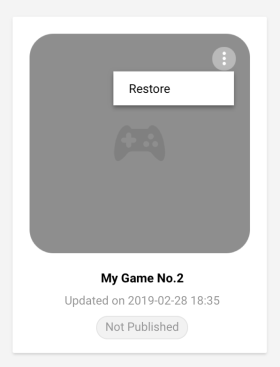Best practices
Purpose
The purpose of this section is to help you verify your UDP implementation is correct, and identify, avoid, or extract yourself from implementation problems. This goes deeper than the FAQs and you should read this before beginning your implementation.
Notion of IAP Catalog
It is important to understand how the IAP Catalog works on UDP.
The IAP Catalog is an inventory of the IAP items implemented in your game. For each IAP item, you define a:
- description
- price
- consumable type
- Product ID
Your game, once repacked and published on a store, will query its IAP item inventory from the store’s back-end. The store is given your game’s IAP Catalog via UDP. When players make in-game purchases, your game asks the store to confirm the IAP Catalog. UDP must be properly implemented in your game for this step to work smoothly.
The IAP Catalog you define in the Unity Editor is synced with the UDP console.
When your game is repacked and submitted to a store, the IAP Catalog is synced with the store’s back-end.

The IAP Catalog on UDP Console is the source of truth for what is submitted to the store’s back-end systems.
If you maintain an IAP Catalog in your game client, your IAP Catalog must be able to sync properly between the Unity Editor and the UDP Console. A misguided implementation of UDP in your game client could prevent the sync from working. Typical symptoms of such a problem in your game would be:
- The wallet doesn’t appear when invoked
- In-app purchases are unresponsive
If these symptoms occur in your generic UDP build, address them right away. They are not solved downstream when the game gets repacked. Failure to address such issues will mean that your game cannot monetize in players’ hands.
We recommend you closely follow the UDP implementation guidance to ensure this is the case. Make sure also that you test your game in the UDP Sandbox environment to ensure that your IAPs behave properly.
If you do not maintain an IAP Catalog in your game client (for instance, your IAP items are maintained solely on your game server) you can still implement and use UDP.
You will have to create an IAP Catalog on the UDP Console, as all stores maintain an IAP Catalog on their back-end and UDP must pass them the corresponding information. See In-App Purchases to understand how to create this setup.
Don’t mix the implementations
There are two different ways to implement UDP in your game:
Note: Choose one implementation method only.
Do not install the UDP Package in your project if you are already using Unity IAP.
Do not enable Unity IAP, if you decided to implement using the UDP Package.
While this would not necessarily break your implementation, you expose yourself to edge cases where your game client would ultimately fail to sync its IAP items with the stores’ servers.
Keep it simple: choose one implementation in the Unity Editor and stick to it.
If your project already has a UDP set up and you try to install another one on top, expect the following errors:
- if trying to install Unity IAP (whilst for instance already having installed the UDP Package), an Installer error is surfaced via a pop-up
- if trying to install the UDP package from the Package Manager (whilst for instance already having installed Unity IAP) an error is surfaced via the Unity Editor console
- if trying to install the UDP package from the Asset Store (whilst already having installed either Unity IAP or the UDP Package from Package Manager), an Installer error is surfaced via a pop-up
If you find out you mixed the two UDP implementations:
- Decide which one you want to keep
- Remove the other
If you choose to implement with the UDP Package, disable Unity IAP.
If you choose to implement via Unity IAP, you must
- Uninstall the UDP Package.
- Install Unity IAP (re-import if needed).
See UDP in the Unity Editor to double-check you’re getting the correct UI elements for the implementation of your choice.
Note: if you’re implementing UDP via Unity IAP, it is normal to have both "Unity IAP" and “Unity Distribution Portal” in the Window menu:
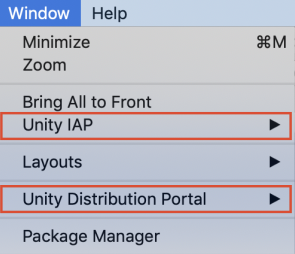
This is because Unity IAP includes a UDP implementation (from version 1.22 and above); the UDP item surfaces in the Window menu when Unity IAP is installed.
UDP in the Unity Editor
There are two different ways to implement UDP in your game:
This section shows how the Editor UI looks in each case.
Editor UI for the UDP Package
So you installed the UDP Package.
You should only have Unity Distribution Portal in the Window menu (that is, you should not have Window > Unity IAP).
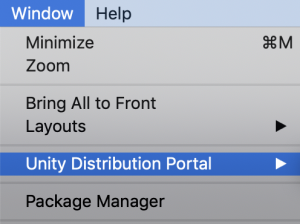
Everything you need is in the UDP Settings inspector window:
Window > Unity Distribution Portal > Settings
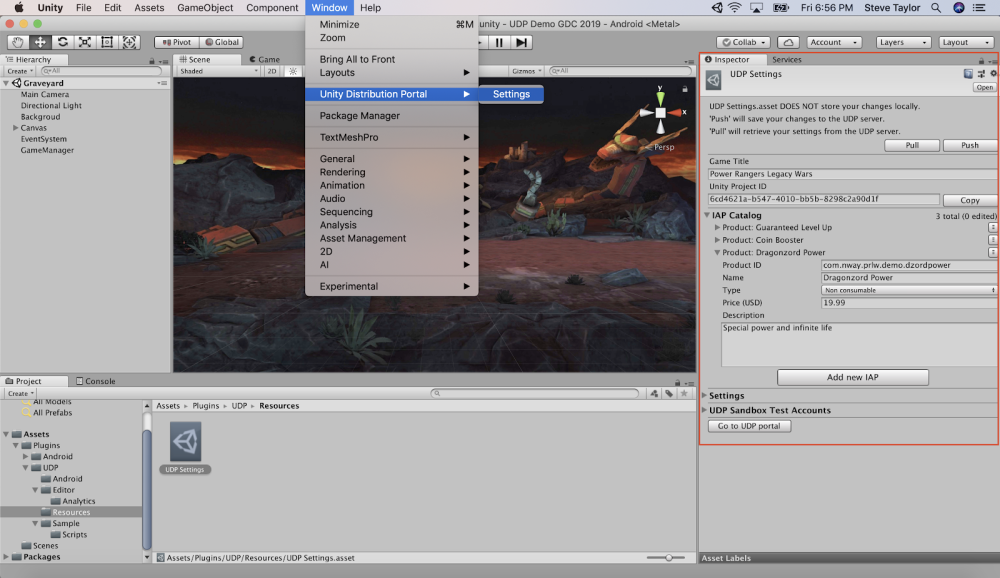
The IAP Catalog for UDP is directly included in the UDP Settings window:

When you add / change IAP Products, make sure you save them to the UDP Console by using the PUSH functions:

The top Push button syncs everything with the UDP console (all IAP Products, Game Title, Settings, Test Accounts).
The Product-specific Push only syncs the information about that IAP Product.
The top Pull button retrieves the latest UDP Settings that were saved on the UDP Console (all IAP Products, Game Title, Settings, Test Accounts). It also overrides any unsaved inputs in your Editor window.
Don’t forget to PUSH your IAP Product changes when you’re done, and before you go on to build your game client.
Keep an eye out for any unsaved changes:

The "edited" label disappears when you’ve synced your IAP Product.
Remember that in the case of an implementation via the UDP Package, you need to explicitly implement in your game the methods explained in Game client implementation with the UDP Package.
Editor UI for UDP with Unity IAP
So you have Unity IAP 1.22 or above installed.
It is normal to have both "Unity IAP" and “Unity Distribution Portal” in the Window menu, as Unity IAP includes a UDP implementation from version 1.22.

Unity Distribution Portal > gives you access to the UDP Settings window specific to the Unity IAP implementation.
Unity IAP > gives you access to the regular Unity IAP features, including the IAP Catalog.
However make sure you are getting the following.
Window > Unity Distribution Portal > Settings opens the UDP Settings inspector window:

The UDP Settings window, for Unity IAP, looks like this:

In the UDP Settings window, you can only set Game Title, Test Account Settings, and view/copy some the UDP client settings.
The IAP Catalog is in a separate window, accessed via the Open Catalog button, or via the menu Window > Unity IAP > IAP Catalog:
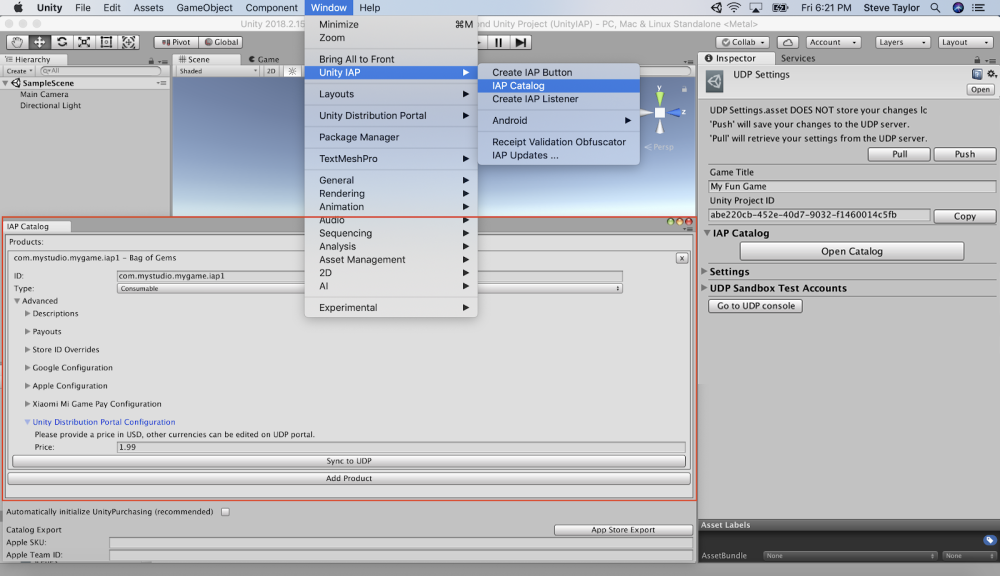
In the Unity IAP Catalog, there is a dedicated UDP section. You must enter your IAP Products in this section for them to become part of the UDP Catalog:

Remember to Sync to UDP every IAP Product that you add to the catalog under the UDP Configuration section, using the button immediately below the price field:

Otherwise your IAP Product is not synced with the IAP Catalog on the UDP Console.
This would result in this IAP Product not being synced with the store.
Before you build, make sure you set UDP as Build Target:
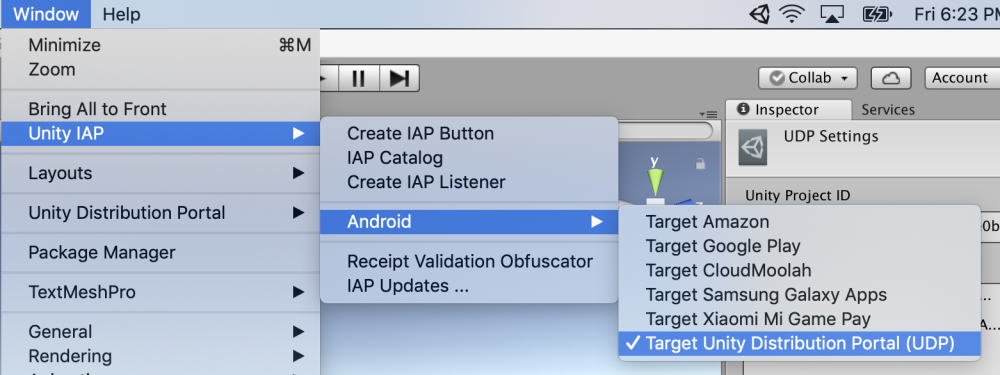
Note: UDP is only compatible with Unity 5.6.1 and above.
If you are using Unity IAP with a lower version of Unity, you will encounter problems.
Save / Sync / Push your IAP Catalog
Save your IAP Catalog before you close it, and before building your game.
Double-check it has synced properly with the UDP console.
Here, "saving" is called
- Sync (in the Unity IAP implementation)
- Push (in the UDP Package implementation)
Other than naming, the two implementations have a slightly different process.
Implementation via Unity IAP
In the IAP Catalog of Unity IAP:

You have to Sync to UDP every IAP Product that you add to the catalog under the UDP Configuration section, using the button immediately below the price field:

Otherwise your IAP Product is not synced with the IAP Catalog on the UDP Console.
This results in this IAP Product not being synced with the store.
Warning: closing the IAP Catalog without syncing the changes doesn’t pop any warning message, so make sure to sync your IAP Products diligently.
The best way to be sure all your IAP Products are synced is to check the UDP Console.
Note: With Unity IAP, the sync of the IAP Catalog is unidirectional: from the Editor to the UDP Console only.
You can (and must) Push your IAP Products from the Editor to the UDP Console, as explained above.
You cannot Pull your IAP Products from the UDP Console into the Editor. The Pull button found in the UDP Settings window only retrieves the Game Title, Settings, and UDP Sandbox Test Accounts last saved on the UDP Console. It does not retrieve the IAP Catalog set up on the UDP Console. If you intend to modify your IAP Products on the UDP Console after your game is built, make sure you implement the AddProduct method before querying your IAP inventory. See Querying IAP inventory for details.
Implementation via the UDP Package
In the IAP Catalog in the UDP Settings window, when you add / change IAP Products, make sure you save them to the UDP Console by using the PUSH functions:

The top Push button syncs everything with the UDP console (all IAP Products, Game Title, Settings, Test Accounts)
The Product-specific Push only syncs the information about that IAP Product.
The top Pull button retrieves the latest UDP Settings that were saved on the UDP Console (all IAP Products, Game Title, Settings, Test Accounts). It also overrides any unsaved inputs in your Editor window.
Keep an eye out for any unsaved changes:

The "edited" label disappears once your IAP Product is synced.
Warning: closing the UDP Settings inspector window without pushing the changes doesn’t pop any warning message, so make sure to push your IAP Products diligently.
Note: With the UDP Package, the sync of the IAP Catalog is bidirectional.
You can (and must) Push your IAP Products from the Editor to the UDP Console, as explained above.
You can also Pull your IAP Products from the UDP Console into the Editor. The Pull button retrieves the Game Title, Settings, and UDP Sandbox Test Accounts, and entire IAP Catalog that were last saved on the UDP console. Do remember that only English descriptions and USD prices are synced between the Editor and the UDP Console.
Double-check your IAP Catalog on the UDP Console
When you’ve synced / pushed all your IAP Products from the Editor side, check the UDP Console has received them.
On the UDP Console, find the In-App Purchases section under your project’s Game Info tab:
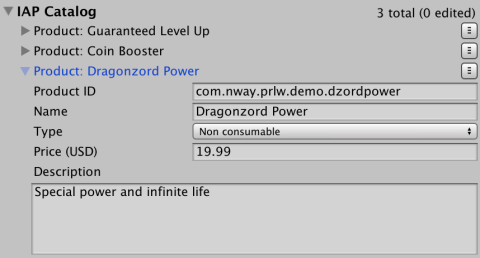

If IAP Products are missing, or are different across IAP Catalogs, you have a problem to look into.
Reminder: if you implemented your IAPs directly in code, you have to enter your IAP products manually on the UDP console, and be vigilant that the Product IDs match the ones implemented in your code. For more information, see In-App Purchases.
Set your Product IDs correctly
When all your IAP Products are created in your game, make sure that they each use the same Product ID as the one set in the IAP Catalog.
Note: Product IDs must follow these requirements:
- Must start with a letter or a digit
- Must be only composed of letters, digits, dots (.) and underscores (_)
- Must only use lower-case letters
UDP stores will reject your game if a Product ID is invalid; in such cases you will be notified of a rejection for the reason "Error: internal server error".
Test your IAPs in the Sandbox environment
If you have a problem upstream, it will not solve itself downstream. Test that your in-app purchases work in your generic UDP build, before you push it to UDP and have it repacked and submitted to the stores.
Once you have built your APK, run it in the emulator or on a real Android device, using the UDP Sandbox Test Environment.
You can set Sandbox Test Accounts directly from inside the UDP Settings window:
Sandbox Test Accounts in [UDP Settings] inspector, for UDP Package:
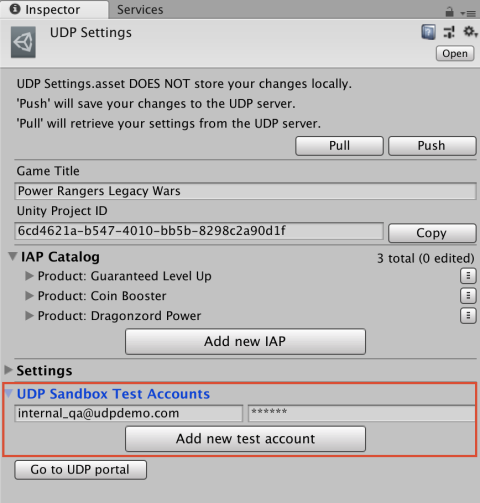
Sandbox Test Accounts in [UDP Settings] inspector, for **Unity IAP:
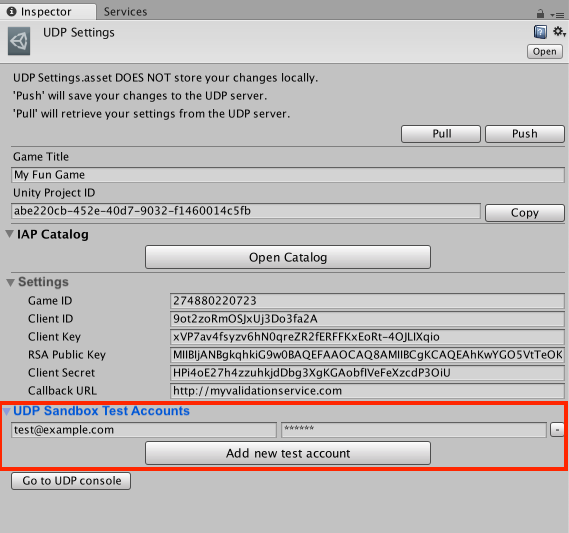
Test your in-app purchases from the emulator or from a real device. If your purchase buttons are unresponsive, or generally if you cannot make a purchase work in the Sandbox environment, something has been implemented incorrectly in your game. Check your IAP / UDP implementation and fix it before pushing to the UDP console and then the stores.
Check your in-app purchase implementation
Implementation via the UDP Package:
The UDP Package implementation requires that you explicitly:
- Initialize UDP
- Query the store’s IAP product inventory
- Request to purchase a product
- Consume the purchase
as explained in Game client implementation with the UDP Package.
Please read carefully and ensure your implementation is compliant. Again, test your in-app purchases in your generic UDP build before repacking it for submission to the stores.
Implementation via Unity IAP:
You do not need to specifically implement the following steps for UDP because your game relies on the underlying Unity IAP implementation. The following is handled by Unity IAP:
- Initialize UDP
- Query the store’s IAP product inventory
- Request to purchase a product
- Consume the purchase
However, your game needs to properly use Unity IAP’s similar functions (such as initialization and purchase) according to the Unity IAP Documentation.
You can also control how you query your IAP inventory.
Note: that the steps involved differ between UDP and Unity IAP. For example, Unity IAP does the "consume" automatically, so there is no API in Unity IAP for the consumption.
Again, test your in-app purchases in your generic UDP build before repacking it for submission to the stores.
Check your Manifest
Make sure your AndroidManifest.xml is compliant with the Android developer guide, otherwise errors will appear when your game is repacked for submission to the UDP stores.
Typically, if you get
- "Error: Unable to compile resources. Please make sure your AndroidManifest.xml is correct or contact support."
it means your AndroidManifest is malformed, and UDP is not able to analyze the APK file.
This can, for instance, be due to elements such as <service>, <activity>, <provider>, <receiver> being outside the
Check your Build Target (if using Unity IAP)
Before you build your UDP game build, make sure the Unity IAP build target for Android is set to "Unity Distribution Portal":

Failure to do so typically prompts errors such as "Error: no UDP SDK detected" when your game is repacked for submission to the stores.
Archive games no longer needed
When you no longer need a game, the UDP console allows you to archive it. You cannot delete a game on the UDP console.
To archive your game:
- Go to the My Games panel.
- Select your filters for the game. By default, you can see all active games.

- Hover over the game to display the More menu (⋮). Archive your game by choosing More > Archive.
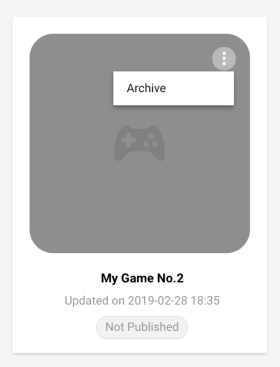
To restore your game:
- Go to the My Games panel.
- Select the Archived filter.

- Hover over the game to display the More menu (⋮). Restore your game by choosing More > Restore.
